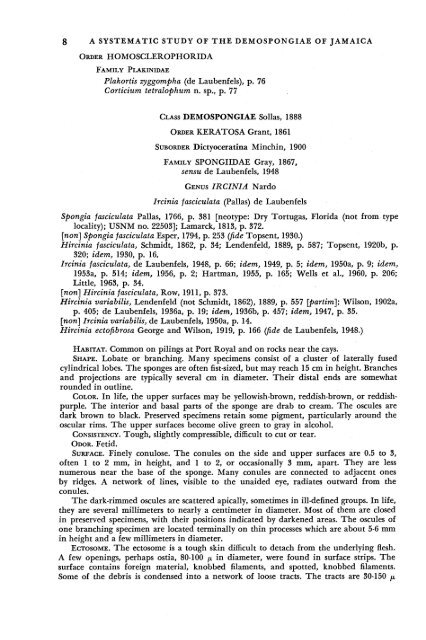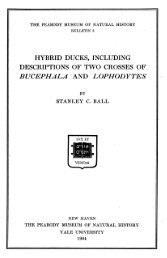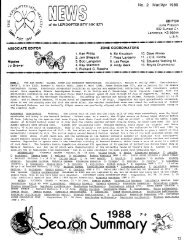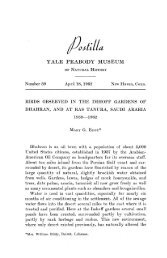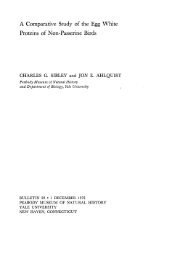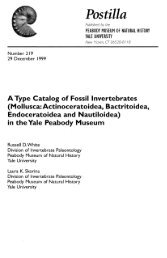Bulletin 20 - Peabody Museum of Natural History - Yale University
Bulletin 20 - Peabody Museum of Natural History - Yale University
Bulletin 20 - Peabody Museum of Natural History - Yale University
You also want an ePaper? Increase the reach of your titles
YUMPU automatically turns print PDFs into web optimized ePapers that Google loves.
8 A SYSTEMATIC STUDY OF THE DEMOSPONGIAE OF JAMAICA<br />
ORDER HOMOSCLEROPHORIDA<br />
FAMILY PLAKINIDAE<br />
Plakortis zyggompha (de Laubenfels), p. 76<br />
Corticium tetralophum n. sp., p. 77<br />
CLASS DEMOSPONGIAE Sollas, 1888<br />
ORDER KERATOSA Grant, 1861<br />
SUBORDER Dictyoceratina Minchin, 1900<br />
FAMILY SPONGIIDAE Gray, 1867,<br />
sensu de Laubenfels, 1948<br />
GENUS IRC INI A Nardo<br />
Ircinia fasciculata (Pallas) de Laubenfels<br />
Spongia fasciculata Pallas, 1766, p. 381 [neotype: Dry Tortugas, Florida (not from type<br />
locality); USNM no. 22503]; Lamarck, 1813, p. 372.<br />
[non] Spongia fasciculata Esper, 1794, p. 253 (fide Topsent, 1930.)<br />
Hircinia fasciculata, Schmidt, 1862, p. 34; Lendenfeld, 1889, p. 587; Topsent, 19<strong>20</strong>b, p.<br />
3<strong>20</strong>; idem, 1930, p. 16.<br />
Ircinia fasciculata, de Laubenfels, 1948, p. 66; idem, 1949, p. 5; idem, 1950a, p. 9; idem,<br />
1953a, p. 514; idem, 1956, p. 2; Hartman, 1955, p. 165; Wells et al., 1960, p. <strong>20</strong>6;<br />
Little, 1963, p. 34.<br />
[non] Hircinia fasciculata, Row, 1911, p. 373.<br />
Hircinia variabilis, Lendenfeld (not Schmidt, 1862), 1889, p. 557 [partim]; Wilson, 1902a,<br />
p. 405; de Laubenfels, 1936a, p. 19; idem, 1936b, p. 457; idem, 1947, p. 35.<br />
[non] Ircinia variabilis, de Laubenfels, 1950a, p. 14.<br />
Hircinia ect<strong>of</strong>ibrosa George and Wilson, 1919, p. 166 (fide de Laubenfels, 1948.)<br />
HABITAT. Common on pilings at Port Royal and on rocks near the cays.<br />
SHAPE. Lobate or branching. Many specimens consist <strong>of</strong> a cluster <strong>of</strong> laterally fused<br />
cylindrical lobes. The sponges are <strong>of</strong>ten fist-sized, but may reach 15 cm in height. Branches<br />
and projections are typically several cm in diameter. Their distal ends are somewhat<br />
rounded in outline.<br />
COLOR. In life, the upper surfaces may be yellowish-brown, reddish-brown, or reddishpurple.<br />
The interior and basal parts <strong>of</strong> the sponge are drab to cream. The oscules are<br />
dark brown to black. Preserved specimens retain some pigment, particularly around the<br />
oscular rims. The upper surfaces become olive green to gray in alcohol.<br />
CONSISTENCY. Tough, slightly compressible, difficult to cut or tear.<br />
ODOR. Fetid.<br />
SURFACE. Finely conulose. The conules on the side and upper surfaces are 0.5 to 3,<br />
<strong>of</strong>ten 1 to 2 mm, in height, and 1 to 2, or occasionally 3 mm, apart. They are less<br />
numerous near the base <strong>of</strong> the sponge. Many conules are connected to adjacent ones<br />
by ridges. A network <strong>of</strong> lines, visible to the unaided eye, radiates outward from the<br />
conules.<br />
The dark-rimmed oscules are scattered apically, sometimes in ill-defined groups. In life,<br />
they are several millimeters to nearly a centimeter in diameter. Most <strong>of</strong> them are closed<br />
in preserved specimens, with their positions indicated by darkened areas. The oscules <strong>of</strong><br />
one branching specimen are located terminally on thin processes which are about 5-6 mm<br />
in height and a few millimeters in diameter.<br />
ECTOSOME. The ectosome is a tough skin difficult to detach from the underlying flesh.<br />
A few openings, perhaps ostia, 80-100 /x in diameter, were found in surface strips. The<br />
surface contains foreign material, knobbed filaments, and spotted, knobbed filaments.<br />
Some <strong>of</strong> the debris is condensed into a network <strong>of</strong> loose tracts. The tracts are 30-150 fi


